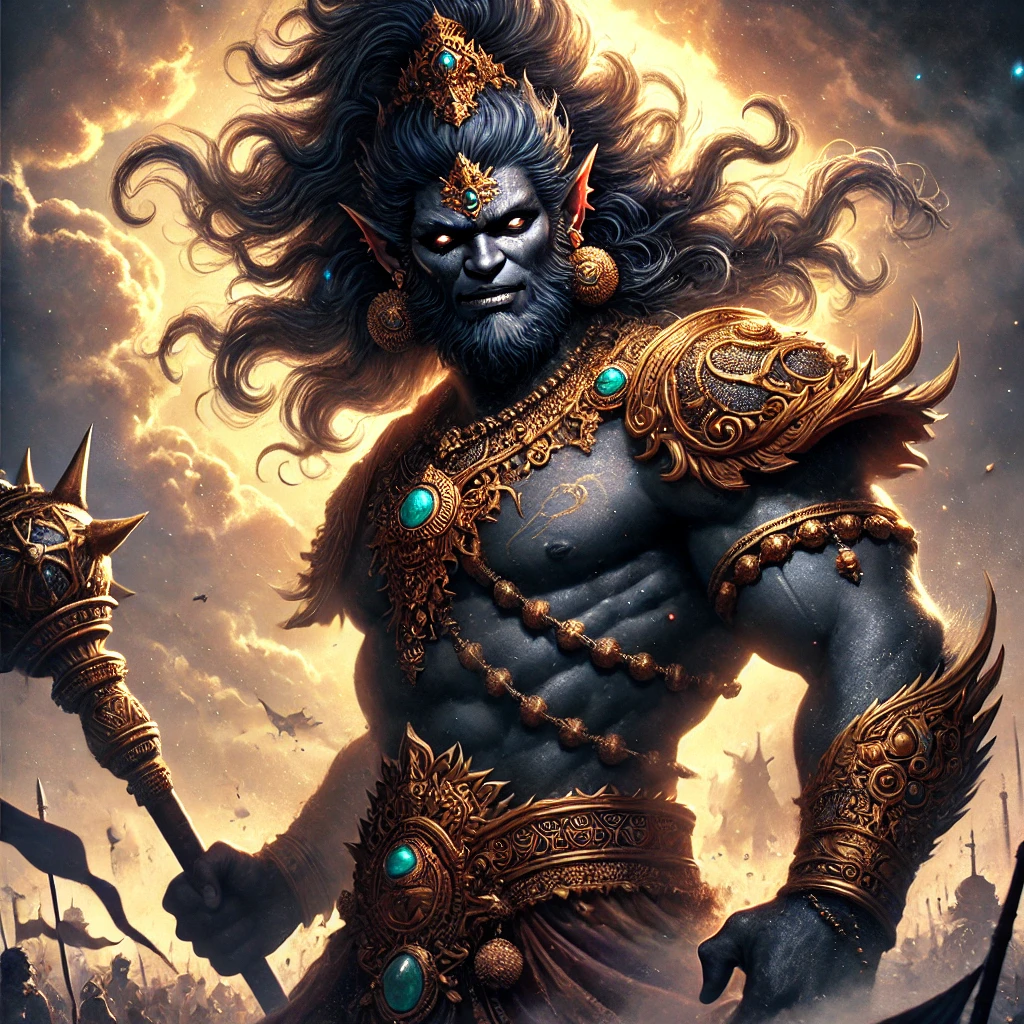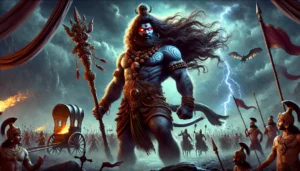
Ghatotkacha half-demon warrior story
Ghatotkacha: The Half-Demon Hero of Mahabharata
The Mahabharata is not just a tale of war; it is a profound tapestry of human emotions, moral dilemmas, and characters who challenge the boundaries of tradition and identity. Among these characters is Ghatotkacha, the enigmatic half-demon warrior whose story adds depth and drama to the epic. As the son of Bhima and Hidimba, Ghatotkacha occupies a unique space in the narrative, embodying the union of humanity and rakshasa heritage, dharma and maya, and valor and sacrifice.
The Birth of Ghatotkacha: A Tale of Unlikely Love
Ghatotkacha’s origin is rooted in an episode of love that transcended race, culture, and societal norms. During the Pandavas’ exile in the forest, Bhima encountered Hidimba, a rakshasi known for her extraordinary beauty and strength. While her brother Hidimb sought to harm the Pandavas, Hidimba fell in love with Bhima, captivated by his strength and noble demeanor.
Hidimba’s love for Bhima led to their union, resulting in the birth of Ghatotkacha. Though their time together was brief, Hidimba instilled in her son a deep sense of loyalty and duty toward his father and the Pandavas. Bhima, too, ensured Ghatotkacha knew his heritage and his role as an ally of dharma.
Table of Contents
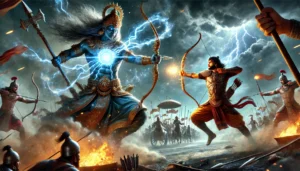
Ghatotkacha half-demon warrior story
Ghatotkacha’s Unique Powers: A Rakshasa’s Might and a Warrior’s Heart
As a half-rakshasa, Ghatotkacha inherited the best of both worlds. His rakshasa lineage granted him supernatural abilities, while his Pandava bloodline imbued him with a strong sense of righteousness and dharma. His powers included:
Immense Physical Strength: Ghatotkacha was a towering figure with strength that rivaled the mightiest warriors. His ability to grow to gigantic proportions during battle made him an awe-inspiring presence.
Maya (Illusion): Rakshasas are known for their mastery of illusion, and Ghatotkacha was no exception. He could conjure illusions to confound enemies, turning the tide of battle in his favor.
Enhanced Night Powers: While all warriors are bound by the limitations of human endurance, Ghatotkacha thrived in the darkness. His powers peaked at night, giving him a significant advantage in nocturnal engagements.
Magic and Sorcery: Beyond physical combat, Ghatotkacha wielded magical weapons and abilities that made him a versatile warrior, capable of adapting to various challenges.
Despite his fearsome powers, Ghatotkacha remained humble and deeply devoted to his family. Unlike many rakshasas in mythology who are portrayed as malevolent, he used his abilities for righteous causes, making him a symbol of dharma triumphing over primal instincts.
The Role of Ghatotkacha in the Mahabharata
Though Ghatotkacha’s appearances in the Mahabharata are relatively brief, his impact on the epic’s trajectory is immense. His actions during the Kurukshetra war highlight his strategic importance and his unwavering loyalty to the Pandavas.
Protector of the Pandavas
Throughout the Pandavas’ journey, Ghatotkacha remained a steadfast protector. Whether it was during their exile or in the great war, he stood ready to offer his strength and powers for their cause. His loyalty to his father Bhima and his uncles was unquestionable, and he viewed their fight as his own.
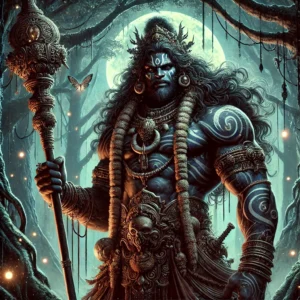
Ghatotkacha half-demon warrior story
Kurukshetra War: The Turning Point
The Kurukshetra war was the ultimate test of Ghatotkacha’s abilities and devotion. His contributions to the war effort were invaluable:
Decimating Enemy Forces: Ghatotkacha’s magical abilities allowed him to wreak havoc on the Kaurava army. He used his illusions to confuse their soldiers, creating chaos and fear in their ranks.
Strategic Nocturnal Battles: The war’s rules permitted nighttime battles, and Ghatotkacha’s powers were at their peak during these engagements. His ability to fight tirelessly and with amplified strength made him a nightmare for the Kaurava forces.
The Ultimate Sacrifice: Ghatotkacha’s defining moment came when he forced Karna to use the Vasavi Shakti, a divine weapon given to him by Indra. Karna had reserved this weapon to kill Arjuna, but Ghatotkacha’s relentless onslaught compelled him to use it prematurely. The weapon killed Ghatotkacha, but his sacrifice ensured Arjuna’s survival, which was critical for the Pandavas’ victory.
The Symbolism of Ghatotkacha’s Sacrifice
Ghatotkacha’s death was not just a strategic advantage for the Pandavas; it was also a profound moment in the Mahabharata, filled with symbolism. His sacrifice represented:
The Triumph of Dharma: By willingly giving his life for the greater good, Ghatotkacha demonstrated that dharma transcends personal desires and attachments.
Loyalty and Selflessness: His actions highlighted the importance of loyalty and the willingness to make personal sacrifices for the well-being of one’s family and community.
The Complexity of Life and Death: Ghatotkacha’s role as a half-demon reminds us that good and evil are not defined by birth but by one’s actions and choices.
Ghatotkacha’s Legacy
Though Ghatotkacha’s life was short, his legacy endures as a symbol of courage, devotion, and selflessness. He is revered not just as a warrior but as a hero who transcended the limitations of his lineage to serve a greater purpose.
In modern interpretations of the Mahabharata, Ghatotkacha continues to inspire discussions about identity, duty, and the sacrifices required to uphold dharma. His story reminds us that true heroism lies in using one’s strengths for the betterment of others, even at great personal cost.
Through his unique heritage, extraordinary abilities, and unwavering dedication, Ghatotkacha has etched his place in the annals of Sanatan Dharma as one of its most memorable and inspiring figures.
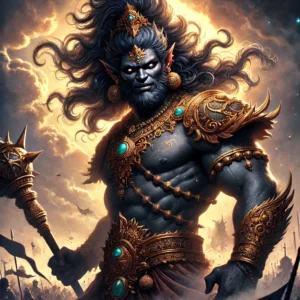
Ghatotkacha half-demon warrior story
FAQs on Ghatotkacha: The Half-Demon Warrior Who Shaped the Kurukshetra War
Q1: Who was Ghatotkacha?
A: Ghatotkacha was the son of Bhima, one of the Pandavas, and Hidimba, a Rakshasi (demoness). His mixed lineage gave him superhuman strength, mystical abilities, and a fierce warrior spirit. Despite his Rakshasa heritage, Ghatotkacha was deeply loyal to his father and the Pandavas and fought for the greater good.
Q2: What made Ghatotkacha unique among other warriors in the Mahabharata?
A: Ghatotkacha’s unique abilities stemmed from his Rakshasa lineage. He could grow to enormous sizes, summon illusions (Maya), and fight more effectively at night. His prowess in magical warfare set him apart from the other warriors, making him a vital asset to the Pandava army.
Q3: How did Ghatotkacha contribute to the Pandava victory in the Kurukshetra War?
A: Ghatotkacha’s magical abilities allowed him to decimate the Kaurava forces. He fought tirelessly against powerful warriors like Dronacharya and Karna, creating confusion and fear in the enemy ranks. His night-time assault disrupted the Kauravas’ strategies, forcing them into desperate measures.
Q4: Why was Ghatotkacha called upon in the Kurukshetra War?
A: Ghatotkacha was called upon to fight during a critical phase of the war when the Pandavas needed an unconventional edge. His Rakshasa powers made him ideal for nighttime battles, where his illusions and strength could overwhelm the Kaurava army.
Q5: What is the significance of Ghatotkacha’s death in the Mahabharata?
A: Ghatotkacha’s death was a turning point in the war. Karna used his divine weapon, the Vasavi Shakti, to kill Ghatotkacha. This weapon, given by Indra, was intended to kill Arjuna. By sacrificing himself, Ghatotkacha ensured the Pandavas’ survival and weakened Karna’s position in the war.
Q6: How does Ghatotkacha’s sacrifice reflect his character?
A: Ghatotkacha’s willingness to die for the Pandavas demonstrates his unwavering loyalty and selflessness. He understood the importance of his role in the war and sacrificed his life for the greater good, embodying the true spirit of dharma.
Q7: How is Ghatotkacha remembered in Indian culture?
A: Ghatotkacha is remembered as a symbol of bravery and sacrifice. Some regions in India celebrate his story through folk art, dance forms, and retellings in local epics. In certain areas, he is worshipped as a demi-god or revered for his heroic contributions.
Q8: What lessons can modern readers learn from Ghatotkacha’s life?
A: Ghatotkacha’s story teaches us about the importance of courage, selflessness, and using one’s unique talents for the greater good. His sacrifice underscores the values of loyalty, family bonds, and prioritizing dharma over personal gain.
Q9: Was Ghatotkacha more powerful than the Pandavas?
A: While Ghatotkacha possessed extraordinary abilities, he was not considered more powerful than the Pandavas in terms of overall skill and divine favor. However, his magical powers gave him an edge in specific scenarios, particularly in nighttime battles.
Q10: How did Ghatotkacha’s Rakshasa lineage influence his personality and powers?
A: Ghatotkacha inherited the mystical abilities and combat instincts of his Rakshasa lineage, enabling him to use Maya (illusions) and grow to giant proportions. Despite his demon heritage, he had a noble and compassionate nature, reflecting the virtuous influence of his father, Bhima.
Q11: Are there any temples or festivals dedicated to Ghatotkacha?
A: While Ghatotkacha does not have widespread worship like other Mahabharata figures, some temples and festivals in India honor his memory. For example, there is a Ghatotkacha temple near the Bhima-Hidimba temple in Himachal Pradesh, where his contributions are celebrated.
Q12: How does Ghatotkacha’s story reflect the concept of dharma?
A: Ghatotkacha’s actions embody dharma as he fulfilled his duties selflessly. Despite being a Rakshasa, he chose the righteous path, fought for justice, and sacrificed his life for the greater cause, illustrating that dharma transcends one’s lineage or background.
Q13: What role did Ghatotkacha’s powers of Maya play in the Kurukshetra War?
A: Ghatotkacha’s mastery over Maya allowed him to create illusions that confused the Kaurava warriors. These tactics helped the Pandavas gain an advantage, particularly during nighttime battles when conventional strategies were less effective.
Q14: How is Ghatotkacha’s relationship with Bhima portrayed in the Mahabharata?
A: Ghatotkacha shared a strong bond with his father, Bhima. Despite being raised in the forest by his mother, Hidimba, Ghatotkacha held deep respect and affection for Bhima. Their relationship highlights the connection between duty and familial love.
Q15: Are there any modern adaptations or depictions of Ghatotkacha?
A: Ghatotkacha’s character continues to inspire modern adaptations in literature, theater, films, and television series. He is often depicted as a powerful and loyal warrior, with his story serving as a reminder of bravery and self-sacrifice.
Summary
Ghatotkacha, the son of Bhima and the demoness Hidimba, is a fascinating figure in the Mahabharata. Half-human and half-demon, he inherited immense physical strength from his father and magical abilities from his mother. These unique traits made him a formidable warrior on the battlefield.
During the Kurukshetra war, Ghatotkacha played a pivotal role in countering the Kaurava forces, especially during nighttime battles when his mystical powers reached their peak. His ability to grow in size, summon illusions, and command supernatural forces caused chaos among enemy ranks.
Ghatotkacha’s most significant contribution came when he sacrificed himself to save Arjuna. Karna, armed with Indra’s celestial weapon (Shakti), intended to use it against Arjuna. However, Ghatotkacha’s heroic intervention forced Karna to deploy the weapon against him instead. Ghatotkacha’s selfless act preserved Arjuna’s life and ensured the continuation of the Pandavas’ mission to restore dharma.
A symbol of loyalty, courage, and sacrifice, Ghatotkacha remains a celebrated yet tragic hero whose actions were instrumental in shaping the course of the Mahabharata.
Related Articles
- Restful Nights: Ayurvedic Remedies and Traditional Indian Practices to Overcome Insomnia and Late-Night Habits
- The Tridevi: Lakshmi, Saraswati, and Parvati – Their Roles and Powers
- “Divine Creatures of Ancient Indian Scriptures: Exploring the Role of Animals in the Vedas, Puranas, and Mahabharata”
- Nature and Spirituality: Exploring the Sacred Essence of the Himalayas, Ganga, and Other Natural Wonders”
- “Reviving the Gurukul System: Relevance and Lessons for Modern Education”
- “Exploring Greek and Indian Mythology: Similarities Between Greek and Indian Mythology “
- “Embracing Sattvic Living: Harmonizing Mind, Body, and Soul Through Food and Lifestyle”
- “Charity and Prosperity: Exploring the Concept of Daan and Its Financial Relevance in Modern Life”
- How to Build an Eco-Friendly Home Inspired by Vastu Shastra
- Comparison of Ancient and Modern Sports: How Traditional Sports Have Influenced Contemporary Games
- “Timeless Lessons from Ancient Tales: Linking Samudra Manthan and Ganga’s Descent to Modern Ecological Challenges”
- “Reviving Sanskrit: How AI is Preserving Ancient Languages for the Future”
- “Mathura: The Sacred Land of Lord Krishna’s Divine Leelas”
- Investing for Future Generations: Lessons from Indian Traditions on Legacy Building and Wealth Preservation
- “Ancient Indian Wisdom: Timeless Lessons for Tackling Today’s Climate Crisis”
- “Artificial Intelligence and Spirituality: Transforming Ancient Practices for the Modern World”
- “Gold and Real Estate in India: Timeless Assets Shaping Financial Strategies”
- Tradition Meets Innovation: The Evolution of Technology in Hindu Rituals
- End-of-World Myths: Exploring Kali Yuga in Hinduism and Ragnarök in Norse Mythology
- Garuda, Pegasus, and Dragons: The Universal Ties of Mythical Beasts Across Cultures
- “Ancient Vimanas: Mythical Flying Machines or Evidence of Advanced Technology?”
- Time Travel in Hindu Mythology: The Fascinating Tales of Kakudmi and King Raivata
- “Divine Feminine Power in Hindu Mythology: The Legends of Durga, Saraswati, and Lakshmi”
- “Divine Beings of Sanatan Dharma: The Spiritual Significance of Sacred Animals in Hinduism”
- “Symbolism in Mythological Art: Unlocking Hidden Meanings in Ancient Temple Carvings”
- “Exploring Technological Advancements in Ancient India and Civilizations: Vimana, Metallurgy, & Water Management systems”
- Unveiling the Mysteries: Ancient Temples of Sanatan Dharma , Mysterious Temples of India
- “The Scientific Knowledge of Sanatan Dharma: Ancient Wisdom Meets Modern Science”
- Ancient Indian Sports and Games: Celebrating a Legacy of Skill, Strength & Strategy”
- “Exploring the Cosmic Link: The Connection Between Astronomy and Vedic Astrology”
- The Power of Sanskrit: Unlocking the Divine Language of the Gods
- “The End of Kaliyuga: A Sanatan Insight into the World’s Final Chapter”
- Explore more articles on Prachin Sanatan Yuga.
Ghatotkacha half-demon warrior story Ghatotkacha half-demon warrior story Ghatotkacha half-demon warrior story Ghatotkacha half-demon warrior story Ghatotkacha half-demon warrior story Ghatotkacha half-demon warrior story Ghatotkacha half-demon warrior story
Ghatotkacha half-demon warrior story Ghatotkacha half-demon warrior story Ghatotkacha half-demon warrior story
Ghatotkacha’s most significant contribution came when he sacrificed himself to save Arjuna. Karna, armed with Indra’s celestial weapon (Shakti), intended to use it against Arjuna. However, Ghatotkacha’s heroic intervention forced Karna to deploy the weapon against him instead. Ghatotkacha’s selfless act preserved Arjuna’s life and ensured the continuation of the Pandavas’ mission to restore dharma.
Despite his fearsome powers, Ghatotkacha remained humble and deeply devoted to his family. Unlike many rakshasas in mythology who are portrayed as malevolent, he used his abilities for righteous causes, making him a symbol of dharma triumphing over primal instincts.
During the Kurukshetra war, Ghatotkacha played a pivotal role in countering the Kaurava forces, especially during nighttime battles when his mystical powers reached their peak. His ability to grow in size, summon illusions, and command supernatural forces caused chaos among enemy ranks.
Barbarika was born to Ghatotkacha, the powerful son of Bhima and Hidimbi, and Mauravi, a princess of the nagas. His unique parentage blessed him with immense strength and supernatural abilities. From a young age, Barbarika exhibited extraordinary prowess in combat and an innate sense of justice. His character was a blend of his father’s demonic strength and his grandfather Bhima’s righteous spirit.

